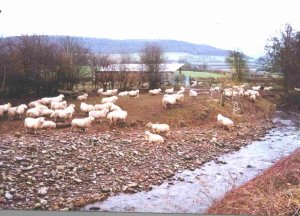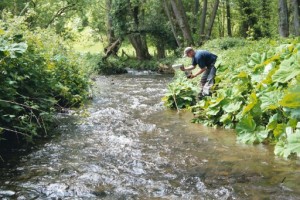Sheep Dip - How the Danger Unfolded
 As long ago as October 1996, the Wye Foundation Habitat Officer visited the Sgithwen brook near Erwood and found large numbers of dead crayfish. Fearing that they were victims of the 'plague' that had destroyed so many elsewhere, he checked above the first waterfall and found the same: all dead along with every invertebrate in the stream.
As long ago as October 1996, the Wye Foundation Habitat Officer visited the Sgithwen brook near Erwood and found large numbers of dead crayfish. Fearing that they were victims of the 'plague' that had destroyed so many elsewhere, he checked above the first waterfall and found the same: all dead along with every invertebrate in the stream.
The Environment Agency was contacted and their water samples revealed the presence of Synthetic Pyrethroid Sheep dip. A prosecution resulted and the Agency conducted a survey of 'at risk' streams in mid and north Wales in 1997 and again in 1998. Much to everyone's surprise and horror, it was Organophosphates that dominated the survey and more than 97% of these streams were affected....
WHY DIP?
Sheep carry many ectoparasites, including sheep Scab, and until recently dipping in chemicals was the best way to treat them. The two main Sheep Dip chemicals used are Organophosphates and Synthetic Pyrethroids. In Wales sheep are often turned out on commons and dipping is the main line of defence against cross infection.
Type of Chemical |
Time Scale of Usage |
Effectiveness on Sheep Scab |
Toxicity for Humans |
Toxicity for Aquatic Life |
Can it be easily neutralised? |
Names of those commonly used |
Organo- |
Used solely until the early 1990 |
High |
High |
High |
Not Easily |
DIAZINON |
Synthetic |
Introduced in the early 1990 |
Low |
Low |
High (100 x more toxic) |
Yes |
CYPERMETHRIN |
Disposal is part of the problem. It was permitted to spread the used dip across a field with the risk of rain washing it into a river or stream. There are now alternative methods that have been introduced which help to reduce the level of pollution. These include injections, jetters or showers and pour-ons.
IS SHEEP DIP REALLY A PROBLEM?
YES!
The results of the Environmental Agency Survey in 1998 clearly shows that the sheep dip pollution is widespread and whilst the Synthetic Pyrethroids are known to be more toxic to aquatic invertebrates, Organophosphates are possibly the major hazard, maybe more than originally realised.
In the 1998 survey 16% of farms visited were found to be a high/very high risk of polluting a stream/river. This was an improvement on the 1997 survey, where 26% of the farms surveyed were found to be of high/very high risk.
However, the results of the surveys showed that far more of the streams are affected than previously thought and it is possible that even these results do not give the whole picture.
YEAR |
Percentage of stream treated in High/Very High risk areas |
Probable length of stream affected |
1997 |
4.9 |
700 km |
1998 |
10 |
1200 km |
Of even greater concern, however, are the findings of recent research, which highlights the dangers to salmonids of the effects of sheep dip in very low doses and synergistic effects with other agricultural chemicals. It appears that the hatching stages of trout and salmon and the migration phases of salmon are significantly compromised, even with doses below the current acceptable levels – down to one part per trillion. There are also concerns regarding the long term retention within stream systems.
HOW DOES THE POLLUTION OCCUR?
-
The actual structures used for dipping are a major concern.
-
Their location (many within 10 meters of a stream).
-
State of repair (some older ones leak/discharge directly into stream/rivers)
-
Whether they are permanent or moveable
-
Accidental spillages.
-
Reckless/illegal Disposal in streams
-
Methods of disposal are a concern too:
-
Spraying over farm land, especially with Organophosphates, which can remain in the soil for a very long time, carries obvious risks in wet upland areas.
-
Whilst it is technically possible to neutralise synthetic Pyrethroids,the small amounts left in fleeces still pose problems
-
WHAT CAN BE DONE?
"A national strategy for sheep dip must achieve a balance between the requirements of the agricultural industry and the need to protect the environment" (Environment Agency strategic review of Sheep dipping; technical report P170).

-
Fishermen can act as first hand detectives by checking for invertebrate life when visiting the rivers. The Riverfly programme is how this can best be done.
-
In depth water quality monitoring, especially during peak dipping times (June - November).
-
Promoting a code of good practice for disease control in sheep, to include appropriate location and construction of dipping facilities.
-
Developing and promoting positive flock management so reducing the need to dip and also the use of alternative methods.
-
Continue ban of Synthetic Pyrthroids in all circumstances. The Forestry Commission currently use SPs to treat young trees and SPs are available for non-veterinary purposes.
The Foundation is promoting river care through its projects and by adding value to streams though the Passport scheme. We see a need for change in the perception by farmers that water courses are a conduit for litter and waste chemicals.
